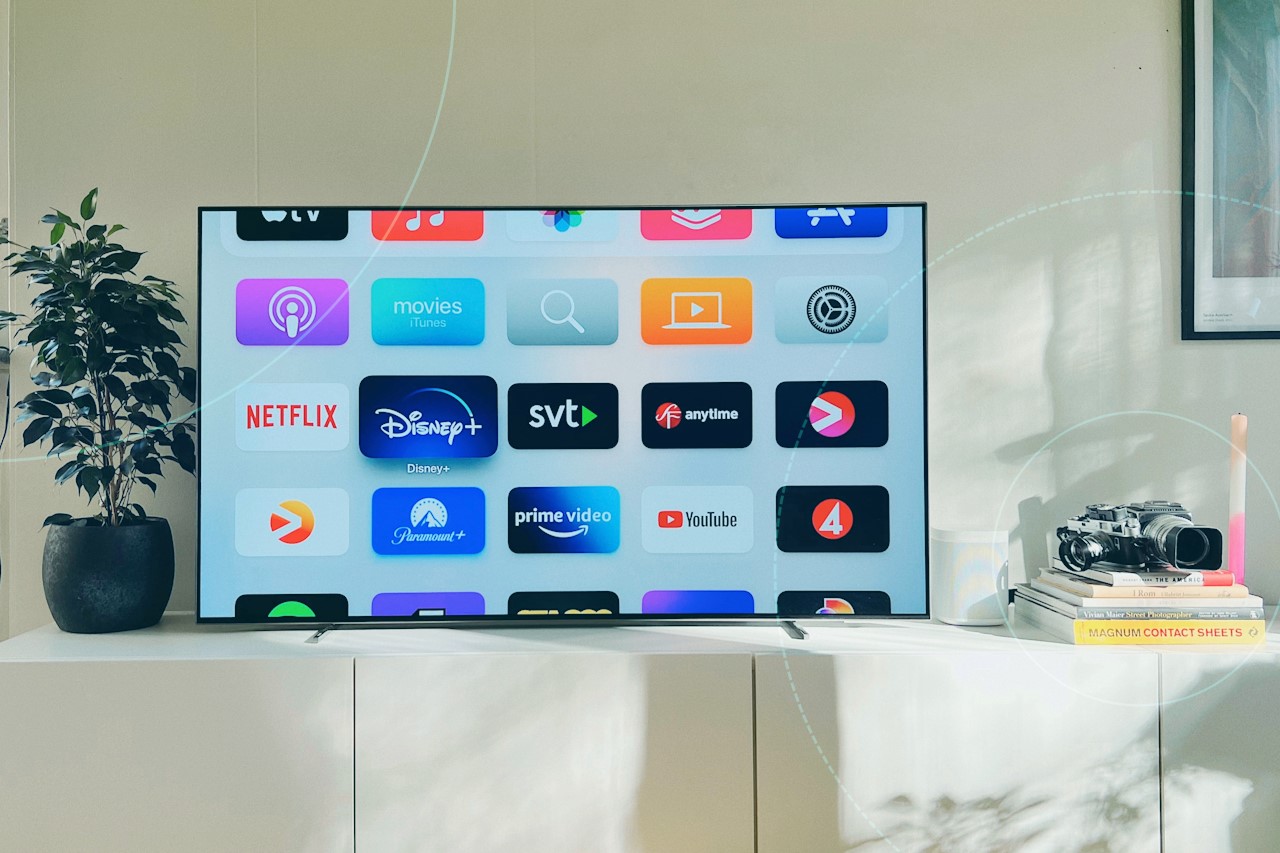Discover essential details about the most popular OTT streaming platforms, including reach, content, whether they display ads, and more in our guide.
Learn which streaming platforms serve ads and offer the best reach for your CTV advertising campaign
Cord-cutting is growing increasingly prevalent among U.S. and global television consumers. Analysts expect nearly 81 million U.S. households to abandon traditional linear TV offerings by 2026 as consumers replace them with the flexibility and cost savings afforded by paid and ad-supported over-the-top (OTT) streaming channels.
New OTT streaming platforms enter the market every year, merge with other channels, or rebrand as content providers continue to evolve their efforts to meet consumers where they are. Read our guide to learn essential details about some of the most prominent options on the market, and use this information to inform your next ad campaign.
Ready to master CTV? Check our our article, Streaming TV Advertising: The Marketer's Complete Guide
11 OTT Streaming Platforms to Consider in 2023
The following is a list of some of the biggest paid and free streaming platforms currently available for consumers in 2023. To help advertisers determine which platform is the best fit for their marketing campaign, we’ve provided insight into each platform's content, total audience reach, what streaming platforms serve ads, and more.
We’ve also compiled expert strategies and insight into the CTV advertising market to help marketers maximize ROAS for their ad campaigns. Learn how to target the right audience, increase your reach, and accurately measure outcomes without privacy concerns by downloading our playbook to CTV advertising today.
Netflix
History: From humble beginnings in 1997 as a mail-order DVD rental service to its current reign over streaming video — Netflix has been at the forefront of disruption within the consumer home video entertainment industry.
Content: Netflix began as a distribution channel for movies and television shows from a variety of production companies. Since 2011, Netflix has branched out into developing and producing its own exclusive content, such as blockbuster hits like Stranger Things and Squid Game.
Audience: With nearly 231 million paid subscribers worldwide, Netflix has one of the largest and most diverse customer bases within the OTT landscape.
Business ownership: Netflix, Inc. is a publicly traded company and owns several film production subsidiaries, including Netflix Pictures, Netflix Studios, and Netflix Animation.
Financial success: Growth has slowed since the beginning of the pandemic in 2020, but revenue remains steady — Netflix generated $7.85 billion in Q4 2022, seeing 1.9% growth year over year. Revenue will likely increase as Netflix continues to roll out its ad-supported model.
Do they serve ads? For years, Netflix only offered ad-free, paid subscriptions for customers. As of November 2022, that’s changed. Now, Netflix provides a less expensive, ad-supported tier, and nearly one million accounts have signed up in the United States since its rollout. This reach will likely increase as Netflix continues pushing this service to new customers in the U.S. and worldwide.
Amazon Prime Video
History: Originally launched in 2006 as Amazon Unbox, the service was renamed Amazon Prime Video in 2008. Subscriptions were initially exclusive to Amazon Prime members, but in 2016, Amazon created a less-expensive, streaming-only option for customers who only wanted access to video content.
Content: Amazon Prime Video features a mix of licensed and original film and television content. Original content is provided by Amazon Studios, creators of popular shows like The Boys and Jack Reacher. Amazon also offers some live content, including its Thursday Night Football broadcasts.
Audience: Amazon Prime Video has around 200 million worldwide subscribers as of September 2022.
Business ownership: Amazon Prime Video is a subsidiary of Amazon.com, Inc.
Financial success: Amazon does not report the financial performance of its Amazon Prime Video service, likely seeing its presence as a lure for customers into the larger Amazon Prime ecosystem. Recent Amazon financial statements describe overall net sales of $149.2 billion in Q4 2022 for the entirety of the company’s operations. Amazon spent an estimated $15 billion on streaming content in 2022 — more than any other OTT company.
Do they serve ads? Yes and no. Amazon Prime Video acts as a wide umbrella for various streaming services. For example, viewers can subscribe to other OTT channels like HBO Max and watch them through the Amazon Prime Video app. Many of these paid options will not include ads (or may only display short ads for other Amazon content). Amazon also offers a free, ad-supported television (FAST) service called Freevee — Amazon Prime Video labels this content as “Free with ads.”
Hulu
History: Hulu was one of the first ad supported streaming platforms on the market. It began as a joint venture between media conglomerates like News Corporation (which includes 21st Century Fox) and Comcast (which includes NBCUniversal) in 2007 as a way for these companies to provide streaming episodes of each company’s television programs. Disney acquired 21st Century Fox in 2019, along with its majority stake in Hulu.
Content: Hulu offers licensed and original on-demand content through ad-supported and ad-free subscription tiers. More expensive tiers include live sports and events, as well as access to Disney+ and ESPN+.
Audience: Hulu has around 48 million subscribers as of January 2023.
Business ownership: The Walt Disney Company currently owns a majority 67% stake in Hulu, with NBC Universal owning the remainder until at least 2024.
Financial success: Annual revenue reached $10.7 billion in 2022.
Do they serve ads? Hulu offers two subscription tiers. Its less-expensive option is ad-supported and does not include live TV. The more-expensive tier includes Disney+ and ESPN+, live TV content, and removes ads from on-demand content — however, live TV content may continue to display ads depending on the content.
Disney+
History: While Disney had experimented with test markets as early as 2015, November 2019 marked the company’s official entry into the OTT market with Disney+.
Content: Disney+ offers a staggering variety of content thanks to its library of legacy content from Walt Disney Studios, Marvel, Star Wars, Pixar, and (thanks to its 2019 acquisition) 21st Century Fox — everything from Peter Pan to Wall-E, from The Avengers to The Simpsons. It also offers a breadth of original content, only available on Disney+, including hits like The Mandalorian and Wandavision.
Audience: Disney+ has 161.8 million global subscribers as of January 2023.
Business ownership: Disney+ is owned and operated by Disney Entertainment, the motion picture, television, and streaming content arm of The Walt Disney Company.
Financial success: Disney+ reported a global average monthly revenue per paid subscriber (ARPU) of $3.93 in Q1 2023.
Do they serve ads? Disney+ currently offers ad-supported and ad-free tiers.
HBO Max
History: HBO Max launched in May 2020, borne out of the merging of two standalone HBO streaming apps: HBO Go, the on-demand streaming app for then-current linear HBO subscribers, and HBO Now, the standalone subscription video-on-demand (SVOD) service. HBO Max is continuing to evolve — in 2023, Warner Bros. Discovery plans to relaunch the service as Max, combining HBO and Discovery content under one banner.
Content: HBO Max pulls from a deep library of Warner Bros. television programs and films, Warner-owned properties like Adult Swim, Turner Classic Movies, and The CW, and third-party content from Studio Ghibli, Universal Studios, and much more. HBO Max also includes streaming-exclusive content like The Flight Attendant and Tokyo Vice. With the upcoming rollout of Max, viewers can expect Discovery’s reality-based programming to join the mix.
Audience: On a Q4 2022 earnings call, Warner Bros. Discovery reported a combined 96.1 million subscriber total across HBO, HBO Max, and Discovery+.
Business ownership: Warner Bros. Discovery owns HBO Max through the subsidiary WarnerMedia Direct, LLC.
Financial success: According to Q4 2022 reporting, Warner Bros. Discovery’s DTC division (which includes HBO Max) generated $2.45 billion in revenue, with CEO David Zaslav citing “significant financial and operating” gains made in its streaming offerings.
Do they serve ads? HBO offers ad-supported and ad-free subscription tiers.
Peacock
History: July 15, 2020, marked NBCUniversal’s entry into the U.S. OTT market after a soft launch with Xfinity customers a few months earlier. The platform has since expanded into the United Kingdom, Germany, Italy, and other European countries.
Content: Peacock offers access to classic NBC and Universal content like The Office, streaming-exclusive original programming like Bel-Air, and third-party content from Paramount, WWE, and the Hallmark Channel. Viewers can also access live NBC networks and sporting events through premium subscription tiers.
Audience: Peacock boasts over 20 million paid subscribers as of January 2023.
Business ownership: Comcast owns Peacock through its subsidiary NBCUniversal.
Financial success: Comcast reported that Peacock generated $2.1 billion in annual revenue for the 2022 fiscal year.
Do they serve ads? Peacock offers three subscription tiers. A free, ad-supported tier offers limited access to its full content library; Premium offers ad-supported access to the full library; and the Premium Plus subscription provides live streaming access to local NBC affiliates and removes ads for everything but live events and a handful of shows and movies.
Paramount+
History: Paramount+ began life as CBS All Access in October 2014, providing live and on-demand content from CBS and local affiliates. In 2019, CBS and Viacom merged again after separating in 2005. The new company rebranded CBS All Access as Paramount+ in 2021 to reflect the addition of content from the numerous brands under its umbrella.
Content: Paramount+ combines on-demand content from Paramount, Comedy Central, MTV, Nickelodeon, and CBS. It also provides live broadcasts for local affiliates and sporting events hosted by the NFL, PGA Tour, and others. Paramount+ is also the exclusive home to Star Trek properties like Star Trek Discovery and Star Trek: Picard.
Audience: As of February 2023, Paramount+ has 55.9 million subscribers.
Business ownership: Paramount+ is owned by Paramount Global (previously known as ViacomCBS until rebranding in February 2022).
Financial success: A Q4 2022 earnings call reported a 30% increase in revenue for direct-to-consumer businesses like Paramount+ and Pluto TV, generating $1.4 billion for the quarter.
Do they serve ads? Paramount+ offers an Essential ad-supported tier and a Premium ad-free tier, though all live content provided through the Premium tier will include commercials.
Apple TV+
History: Apple TV+ launched in March 2019 to expand its service offerings beyond its Mac and iOS App Stores. With a low monthly fee and an initial focus on original content, Apple TV+ debuted in around 100 countries — far more than any other competition.
Content: Apple TV+ offers a variety of original shows and films from high-profile creators and production companies. Highlights include For All Mankind, Severance, Ted Lasso, and Tetris. As of mid-2020, Apple began licensing third-party content like Fraggle Rock and Peanuts, as well as MLB and MLS sporting events, to flesh out its offerings and retain subscribers over the long term.
Audience: Apple does not reveal subscriber counts, though analysts estimate that the service has at least 33.6 million subscribers as of May 2021.
Business ownership: Apple TV+ is owned by Apple Inc.
Financial success: Apple does not disclose Apple TV+ revenue specifics, instead lumping it along with App Store and Apple Pay revenue in its “Services'' segment. The company reported an “all-time revenue record” of $20.8 billion within this segment for Q1 2023.
Do they serve ads? Apple TV+ currently does not show ads on most of its content (though the company does have an ad deal for its Friday Night Baseball offering). Apple has made some recent hires that hint at an ad-supported future, though the company has not confirmed its plans at this time.
YouTube TV
History: YouTube founded YouTube TV as a supplement to its main, user-curated offering, providing users with a streaming alternative for accessing conventional linear TV programming. YouTube TV originally launched in April 2017 in select U.S. markets, fully expanding into the rest of the country by March 2019.
Content: The service offers live programming and on-demand content from several providers, including major broadcast networks like ABC, NBC, and CBS; cable networks like Disney Channel, BBC America, and Cartoon Network; along with sports and movie networks like NBA TV and Starz.
Audience: YouTube announced a combined 5 million subscriber count across its paid and trial options as of July 2022.
Business ownership: YouTube TV is a product of YouTube, a wholly-owned subsidiary of Google LLC.
Financial success: Google does not report financial numbers for YouTube TV, instead grouping them as “Google Services” alongside YouTube, Google Play, and other offerings. Google reported $67.8 billion in revenue in Q4 2022 for Google Services, with total YouTube ad revenue reported at around $8 billion.
Do they serve ads? YouTube TV subscribers will see ads in live content, recorded content, and select on-demand content.
Sling TV
History: DISH Network had ideas for creating a virtual multichannel video programming distributor (VMVPD) supplement to its satellite offering as far back as 2012, officially launching Sling TV in February 2015. The service began as a way to target cord-cutters with cheaper streaming bundles of linear TV programming, specifically in the 18-35 demographic.
Content: Sling TV has partnered with a wide variety of networks to provide live and on-demand content, including ESPN, TNT, CNN, Disney Channel, and more. Viewers can subscribe to one of two packages (or both, combining content offerings) and add on additional news, family, and movie programming bundles as needed.
Audience: Sling TV reported a total of 2.3 million subscribers as of January 2023.
Business ownership: Sling TV is a wholly owned subsidiary of DISH Network.
Financial success: DISH Network does not disclose revenue for its Sling TV business, though it reported total revenue of $16.68 billion for Q4 2022 across all operations.
Do they serve ads? While Sling TV offers free and paid subscription tiers with varying access to live and on-demand movies and TV shows, all content on Sling TV is ad-supported.
The Roku Channel
History: Long known for its famous line of streaming set-top boxes, Roku launched The Roku Channel in September 2017 to provide free, ad-supported content for Roku device owners. Roku made the channel further accessible outside the Roku ecosystem via a website in August 2018.
Content: In addition to licensed content from production companies like Sony Pictures, Paramount, and Warner Bros., The Roku Channel offers exclusive original content like Heathers: The Musical and Weird! The Al Yankovic Story.
Audience: The Roku Channel reached over 70 million global accounts as of January 2023.
Business ownership: The Roku Channel is a product of parent company Roku, Inc.
Financial success: Roku does not release financial specifics regarding The Roku Channel, but it has reported $2.7 billion in annual platform revenue, which includes ad sales, distribution, and other revenue streams.
Do they serve ads? All Roku Channel content is provided for free and is ad-supported.
Leverage OTT Streaming Platforms to Maximize ROAS
Choosing the right platform is only half the battle. Getting the most out of advertising on OTT streaming platforms requires having a firm grasp of the platform’s strengths and the ability to leverage them to their fullest potential.
To help, we created The Essential Guide to CTV Advertising for Search and Social Marketers. It’s chock full of expert insight, critical strategies, and answers to the most frequently asked questions marketers have when they enter the CTV advertising landscape. Download our free ebook today, and learn how to boost reach, accurately track conversions, and maximize ROAS.







